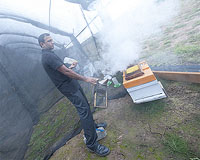 |
College Park MD (SPX) Feb 14, 2011 Under our feet and ubiquitous, lowly soil can be easily overlooked when it comes to addressing climate change and population growth. But in the January-February issue of the Soil Science Society of America Journal, a team of scientists say soil is an essential piece of the biosphere and more attention should be paid to protecting it. Strategies for doing so include refocusing and boosting research, and communicating its importance to the public. "The article is a call to better engage with each other and with those concerned about the coming stresses to the planet," said soil scientist Cesar Izaurralde of the Joint Global Change Research Institute in College Park, Md., a collaboration between the Department of Energy's Pacific Northwest National Laboratory in Richland, Wash., and the University of Maryland. "A better understanding of soils is needed to help us weather the changes, many of which will be around for future generations to contend with." While people don't think much about soil, it quietly and continuously services life on Earth. Soil provides the basis for food and fiber production; it supports a diversity of plant, animal, and microbial life; it regulates nutrient cycles and gas exchange with the atmosphere; it cultures our inner feelings for home, for place, for renewal of spirit. However, changes occurring to our planet are affecting the services provided by soil. Whether these changes are natural or stimulated by the activities of an ever-increasing population, there is an urgent need to rejuvenate the essential services provided by soil. After all, soil depletion has hastened the collapse of at least one society, the Greeks, and contributed to economic hardship as recently as the last century in the Great Plains of the United States. The international team of researchers suggest how soil scientists and others can work together to devise strategies to save the soil for the benefit of the planet, the people that inhabit it now and in the future, and all other life that depends on human stewardship. Representing the 2008 Emerging Issues in Soil Science Committee of the Soil Science Society of America, this team defined some of the most urgent questions that humanity will be facing in coming decades and explored ways that research in soil science might help address those questions. In their broad discussion, the scientists address eight critical issues: demands for food, water, nutrients, and energy, and the challenges of climate change, biodiversity loss, biological waste recycling, and global resource equity. For example, feeding the burgeoning population will require planning to protect the soil and environment, and managing soil can help people use dwindling pools of freshwater more wisely. Nutrients in the soil can be depleted, so it will be important to preserve soil's fertility while improving harvests. Climate change will undoubtedly affect the productivity and resilience of soil, and soil underpins the biodiversity of organisms large and small. Using soils to recycle biological wastes has the potential to replenish our invaluable renewable resources. Finally, soil is the skin of the Earth and as such must be viewed as a global resource managed locally. The authors recommend four steps soil scientists should take to address these critical issues. They include refocusing research to the most urgent problems, broadening their vision from soil to entire ecosystems, enticing young scientists to pursue careers in the field, and improving soil science's image problem with better stories of its past successes and future prospects. The conversations the researchers hope to elicit may help direct soil science toward greater relevance in preserving our fragile home on this changing planet. Reference: H.H. Janzen, P.E. Fixen, A.J. Franzluebbers, J. Hattey, R.C. Izaurralde, Q.M. Ketterings, D.A. Lobb, W.H. Schlesinger, Global Prospects Rooted in Soil Science, Soil Sci. Soc. Am. J. 75:1-8, DOI: 10.2136/sssaj2009.0216.
Share This Article With Planet Earth
Related Links DOE/Pacific Northwest National Laboratory Farming Today - Suppliers and Technology
 Pheromone Increases Foraging Honey Bees, Leads To Healthier Hives
Pheromone Increases Foraging Honey Bees, Leads To Healthier HivesCorvallis OR (SPX) Feb 14, 2011 The application of a naturally occurring pheromone to honey bee test colonies increases colony growth resulting in stronger hives overall, according to a new study conducted by scientists at Oregon State University and Texas A and M University. The study, which appeared this week in the journal, PLoS ONE, comes amid national concern over the existence of honey bee Colony Collapse Disorder ... read more |
|
| The content herein, unless otherwise known to be public domain, are Copyright 1995-2010 - SpaceDaily. AFP and UPI Wire Stories are copyright Agence France-Presse and United Press International. ESA Portal Reports are copyright European Space Agency. All NASA sourced material is public domain. Additional copyrights may apply in whole or part to other bona fide parties. Advertising does not imply endorsement,agreement or approval of any opinions, statements or information provided by SpaceDaily on any Web page published or hosted by SpaceDaily. Privacy Statement |